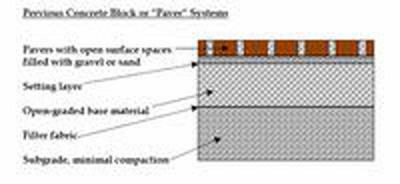Pervious Paving
Pervious paving is a catch-all category for a variety of paving materials that allow water to infiltrate into the ground and prevent runoff. All rely on pervious material placed over an open-graded base material underlain by a minimally compacted subgrade. Examples of pervious paving include paving blocks (numerous shapes and sizes), plastic grids that allow grass growth between the plastic, pervious concrete, and pervious asphalt. The numerous different types of pervious paving materials provide flexibility in choosing the most appropriate system for the usage.
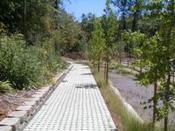
Specifications
If intended to support vehicles, pervious pavement areas must be designed by a professional engineer, registered in the state of Oregon.
Otherwise, paths may be installed based upon manufacturer’s specifications and recommendations. A key factor to consider when designing pervious pavement areas is the infiltration rate of the underlying soil. Additionally, installation of the system is critical – compaction of the underlying soil and subgrade must be minimized to ensure that void spaces are not compacted. Proposed use of the area (traffic volume and weight, speed, etc.), maintainability, and aesthetics are among other factors to consider when selection a pavement system and designing the system. Pervious pavement systems cannot be used on sites with a likelihood of high oil and grease concentrations, including fast food establishments, automotive repair and sales, and parking lots with greater than 1000 average daily trips.
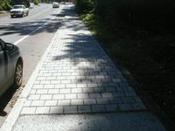
Although pervious pavement areas are appropriate for all soil types, soils that infiltrate less than 2 inches per hour, as is common in Sandy, require an underdrain system to an approved stormwater conveyance system. There must be at least 3 feet of undisturbed soil between the bottom of the base rock and any impervious layer or seasonal high water table, or an underdrain system must be used. Slopes must be less than 10%. Manufacturer’s specifications must be followed for any system installed.
Planting Specifications:
Not applicable
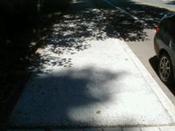
Maintenance Requirements:
Due to the variety of types of pervious pavement, maintenance requirements vary, and all of those listed below may not apply to a particular area.
- Areas of pervious pavement shall be swept to prevent the clogging of pore spaces and to prevent pollutants from contaminating stormwater
- Vegetation (where appropriate) that interfere with porous pavement operation shall be pruned or removed
- Vegetation (where applicable) shall be maintained as appropriate and fallen leaves and debris shall be removed from the pavement
- Where vehicles will have access to the pavement, additional sweeping or vacuuming may be necessary
- Signage may be used to educate the public about the pavement system and how to help maintain it
Locations in Sandy
Dubarko Road at Tickle Creek
Hamilton Ridge subdivision – path to Tickle Creek
Meinig Park entrance at McCormick Ct
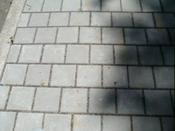
Resources Used
- City of Gresham Department of Environmental Services Stormwater Division. Water Quality Manual. Summer 2003.
- City of Oregon City. City of Oregon City Stormwater and Grading Design Standard; Chapter 5 of City Code.
- City of Portland Bureau of Environmental Services. Stormwater Management Manual. July 1, 1999; Revised 2004
- Clean Water Services. Design and Construction Standards for Sanitary Sewer and Surface Water Management. March 2004.
- Additional information and resources are available on the City of Portland Bureau of Environmental Services web page

